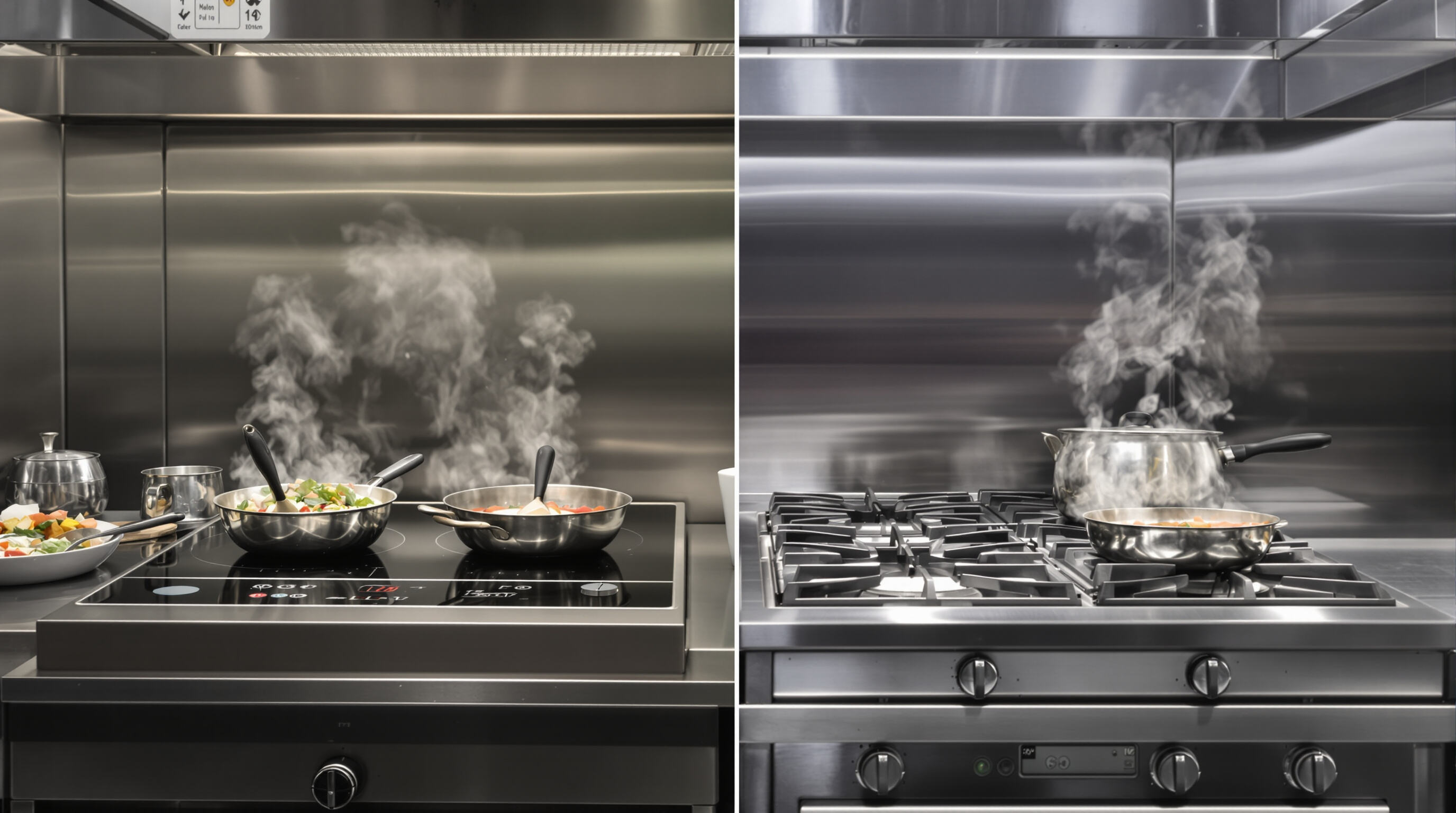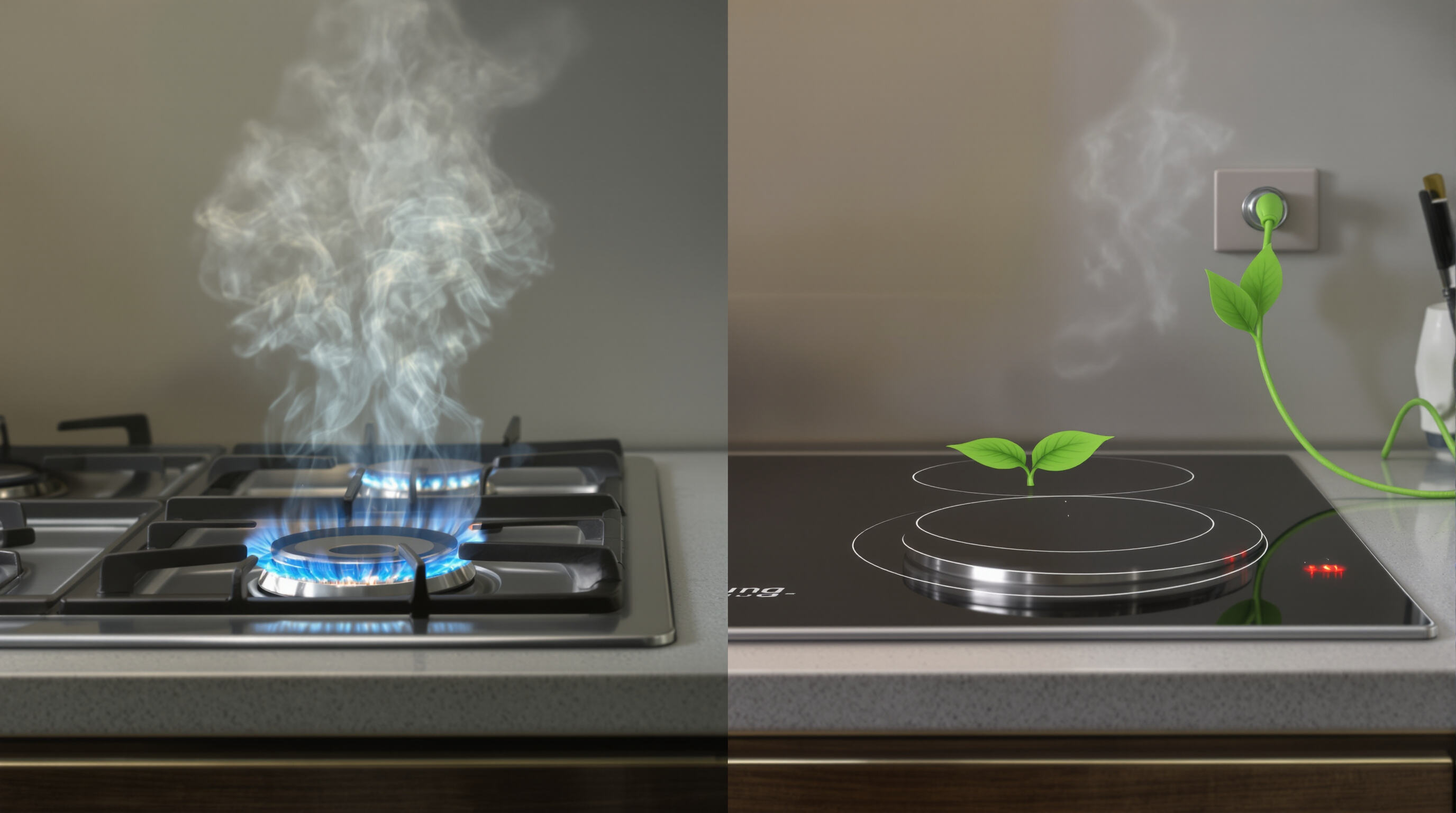Nuntii
Inductio vs. Gas Coquendi Instrumenta: Quae Tuum Viridarium Tabernae Coempta Sunt
Energiae Affectus: Quomodo Inductio Gas in Coquinis Commercialibus Superat

Inductio vs. gasi translatio energiae: Intellegere differentiam efficacitatis
Inductio coquendi efficitur 85-90% energiae affectus utens campis electromagneticis ad vasa coquendi directe calefacienda, comparata cum gasi systematis quae 60–70% energiae in perdendo calore ambiente (LinkedIn 2024). Haec fundamentalis differentia in energiae translatione lacunam praebet:
- Gas: Calefacit aerem circa ardores, amittens 18,000–35,000 BTU/hr in ambiente
- Inductio: Canalis 1,500–3,500 vatt directe in vasa coquendi cum minima dispersione
Studium efficientiae apparatum 2024 invenit inductiones 2.8x plus coquendi productum per energiae pecuniam quam gas, cum 86% energiae utilis versus tantum 31% pro gas (SolarQuotes).
Mensurae praestationis in mundo reali: Comparatio producti BTU et watturae
| Metricus | Fornus gas | Cucurbita inductionis |
|---|---|---|
| Input energiae | 35,000 BTU/hr | 3,500 vatt |
| Output effectivus | 10 850 BTU (31%) | 3 010 wattii (86%) |
| Tempus Ebullitionis Aquae | 8,5 minuta | 4,2 minuta |
Ceratae inductionis possunt minorem vim in scriptis habere, sed cibo parando tamen cum gaso aequiperant, dum circa dimidiam partem energiae consumunt. Exempli gratia, in testibus realibus, ignis inductionis vulgaris 3,5 kW sex litros aquae in modico plus quam quinque minutis ad ebulliendum reducit, quod superat tempus octo et dimidii minutorum quod ignis gasosus 12 000 BTU requirit. Haud dubium, haec tempora paulo tardiora sunt quam quae in laboratoriis solent observari, sed tamen inductionis methodus clare praeferenda est. In sumptibus etiam eadem ratio apparet. Tabernae quae octo horas cotidie operantur annum singulum circiter 1240 $ gaso impendunt, inductione autem tantum fere 720 $ secundum recentes indicatos anni 2024.
Praecisio et reductio inutilis: Quomodo inductio adiuvat coquendum efficienter in energia
Inductionis temperaturae regula instantanea (±1°F accurate) tollit augmenta energetica quae ex flammae gaseae modulatione oriuntur. Coquinae mercatales nuntiant 15–20% minor res perditae propter:
- Non opus praecaudere 92% vasorum compatibilium
- Detectio automata penthi quae zonas inutilizatas claudit
- 70% celerius recuperatio caloris post removal of lid
Potestas tenendi ebullitionem firmam iuxta gradus 150 Fahrenheit significat nullam amplius excessiones temperaturae sicut evenit saepe cum focis a gaso. Apparatus a gaso solent perdere circa 1,2 kilowatt-horas per horam in singulis fornentis dum operantur. Unum locum pizzarum Bostoniae reduxit dissipatio energiae fere duabus tertiis parte post conversionem. Eorum maximam partem lucro adsecuti sunt eiciendo semper ardentis flammas pilotos, quae solum 16 percentum gasi conservabant. Domini quoque coepere magnitudines fornentium aptare ad vasa sua coquendi et constituere specificas temperaturas ad varia pizzae parta per diem in culina.
Energiae Affectus: Quomodo Inductio Gas in Coquinis Commercialibus Superat
Inductio vs. gasi translatio energiae: Intellegere differentiam efficacitatis
Ceramicas inductionis ad 85 ad 90 percentum energiae suae in ollas et patinas mittunt, dum fornaculae gasi traditae vix ad 35 ad 40 percentum efficacitatis perveniunt, secundum data DOE anno 2023. Maximus pars quae perditur, calore radiante aut per aerem movente, effugit. Quod hoc rei significat? Numeros aspice: ceramica inductionis 3.5 kilowattae aequaliter bene operatur quales vetustae unitates gasi 12000 BTU quas ubique videre solebamus. Sed hic est modus - 38 percentum minus electricitatis utitur. Ita coquere per inductionem non solum melius est ad conservandum energiam, sed etiam celerius cum temperaturas durante cibos regulas.
Mensurae praestationis in mundo reali: Comparatio producti BTU et watturae
| Metricus | Fornax Gas | Cucurbita inductionis |
|---|---|---|
| Productio Caloris Efficax | 12000 BTU (35%) | 3.5 kW (90%) |
| Tempus Ebullitionis (Aqua 6L) | 8.5 minuta | 5.2 minuta |
| Annua Custo Energiac* | $1,240 | $720 |
| *Basis est in operatione quotidiana 8-stundorum (NRA 2024) |
Haec metricalia confirmant inductionem superiorem in usu energiae vertere directe in celeriores coquendi tempora et minores sumptus utilitatum, etiam si rationem custodias electricitatis habeas.
Praecisio et reductio inutilis: Quomodo inductio adiuvat coquendum efficienter in energia
Cocina per inductione non solum tempus servat apud focum sed etiam res frivolas minuit ratione structurae suae. Cum coqui ignem inductionis accendunt, nullum opus est ut calorem serpentinorum exspectent aut ignem ardentem curent cum non opus est. Systema statim respondet, ita ut restaurantes energiam non amittant dum machinae parant. Praeterea, hi furni novi sensorem habent qui potestatem in sectionibus non usitatis non dissipant. Quaedam restaurantia provida inductionem cum arte intelligente adhibent. Haec machinae sapientes ad 91% efficientiam pervenire possunt caloris quantitatem secundum victum mutantes et etiam variis coctionis conditionibus pro diversis ingredientibus sciens. Haec exactitudo in factis et in expensis energiae et in impetu environmentali interest.
Lucrum diuturnum et reditus investitionis pro restaurantibus viridibus
Ad inductionem culinariam converti rem finanziariam proficiscitur, ut ostendit officina caffei localis sine inutili quae eorum facturam energiae post conversionem minuit 37%. Etiam duobus modis magnis pecuniam conservaverunt. Primo, iam non oportet impendere in examinanda regulariter ductorum gasi. Secundo, necessitates aquae refrigerandae 28% minuuntur. Officina omnes pecunias suis redivit intra biennium et tria mensis. Quod rem meliorem reddit est quod haec conservatio sua initia viridis auxit. Pecunia accessit directe in programmatibus eruditionis staff ad instituta sustinenda, creans realis utrumque vincit situatio pro utraque parte et metis environmentalibus.
Summa custodia: Cur maior impensae initiales ducunt ad minores impensas totius vitae
Licet inductionis instrumenta altiorem pretium initiale habeant, tamen parant conservationes diuturnas in pluribus campis:
- Ventilationis necessitates cadunt 60–80% sine productis combustionis
- Media salus utilitatum de $5,200 singulis annis pro singulis range
- Costae conservationis decrescunt 45% propter minora partes motus et nullam curam ductus gasi
Data verificata a Energy Star monstrat inductionis costam mensalem operativam 68% minorem esse quam gasi, cum pecuniae parvatae longe ultra punctum aequilibrium crescant et praebent firmas reditus netas per cyclum vitae decennalem
Trendi industriae: Inductio sana et integratio AI quae futuras pecuniae parvatas movet
Hodiernae systemae coctionis inductionis sapiunt fieri per technologiam AI quae cernere potest quando mendantur usque ad duas septimanas ante tempus. Etiam modificant sese caloris rationes pro diversis ciborum generibus. Systema automaton variat potestatis niveaux prout constat electricitas pretio in quolibet tempore secundum pretia retis. Hoc 18% circiter minuit in expensis horarum summatum, secundum recentes experimenta in culinis restauracionum. Pro magistris coquinis in locis amicis ambientis, haec praestantia meliorem dominationem efficit in expensis mensalibus tamenque rem perite agens. Multi refectorii virides narrant millena singulis annis conservata esse ex his modis sapientibus sine performance aut clientium contentione amissa.
Incidens Ambientalis: Emissio Carbonis et Perpetuitas per Coctionis Genus

Cum machinis culinariis eligendis, curatores qui in sustentabilitate versantur tum emissionibus directis tum itinere environmentali diuturno considerando opus est. Coctio per inductionem praestantias claras praebet prae gas in emissionibus operativis et per totam vitam.
Emissio per vitam: Inductio vs. gas a culina ad retia
Cucinare col gas libera anidridum carbonicam directe ad focum durante combustionem, praeterea emit methanum ab eo tempore quo effoditur usque dum domos pervenit. Methanum autem pro climato vix 84 vicibus deterius est quam communis CO2 si consideramus spatium temporale viginti annorum. Inductionis vitroceramicae nullas emissiones loco suo generant. Quod maxime refert pro eorum impetu environmentali est quinam typi stationum electricarum energiam subministrant. Secundum quendam studium quod omnia consideravit a productione usque ad depositionem, coquere per inductionem tandem circa 30 percent minus totius emissionis generat post decem annos, etiam in locis ubi pleraque electricitas adhuc e carbonibus vel plantis gas naturalis provenit.
Methani effusio et rete electrica decarbonizata: Quomodo ipsae afficiunt electiones virides in coquina
Systēma americānum gasīs naturalibus annuōs fere 2,3% eōrum quae ut mēthanum vehit amittit, quod validē argumentum laedit quod gas naturale pro ūniversō bonum sit. Ex alterā autem parte, inductiōnīs technologia melior planetāriē melioratur cum temporibus, quia rete potestātis ad fontēs renovābilēs movetur. Vidimus nātiōnālis rēte carbonīum lēvārī inter 5 et 7 percentum quotannis passim. Quod hae rēs nōs docet est inductiōnīs apparatus diūtius usī vīrēscere, dum tamen machinae gasōsae eundem emissiōnis modum semper effundunt. Quīcumque dē sustentābilitāte serius cogitāvit, inductiōnīs coquendī longē sapientius eligitur.
Studiōrum exemplum: Rēctōriī quīdam ā Michelinō recognitī īnsuccessū omnēs inductiōnīs ūsūs
Clāra ēditōria sustentābilis omnem suam gasī cōnjugātiōnem inductione substituit, creāns coquinam sine combustionis. Post ūsūm rēsultāta comprehendēbant:
- Mōnōxīdum carbonis lēvels dē 9 ppm ad nōn dētectōs dēcīdit
- Usus energiae ventilationis 40% decrementus est
- Aer auctores meliorem significanter nuntiaverunt
- Emissio carbonis annua 32 tonniis minuta est
Haec transformatio ostendit quomodo ad inductionem conversio praebet emensurabiles emolumenta environmentalia dum tueatur coquinariae securitatem et operariorum commodum—demonstrans quod coctura alti operis et sostenibilitas simul esse possunt
Sectio FAQ
Quae est differentia in efficientia energetica inter caminas inductionis et caminis gasi?
Caminas inductionis 85–90% efficientiae energiae adipiscuntur dum caminis gasi tantum 35–40% efficientiae adipiscuntur propter caloris amissione extrinseci
Quomodo coctura inductionis ad longinquas conservationes pecuniariae confert?
Coctura inductionis minuit expensas energiae facturas, expensas conservationis, et necessitudinem ventilationis, cum utilitatum conservatione aestimata ad 5200 annis singulis pro area
Potestne coctura inductionis emolumenta environmentalia habere?
Ita, coctura inductionis in emissione carbonis infra decem annos resultans meliorat dum in potestatem rete migrat versus fontes renascibilis energiae
Quae sunt praecipua usus inductionis in culinis commercialibus?
Inductionum focis instantanea temperatura regatur, praecisio maior, energia minore lugebatur et celerius coquendi tempus, efficaciam et sustentabilitatem augendo.
 Post-Sales:
Post-Sales:
 EN
EN
 AR
AR
 HR
HR
 NL
NL
 FI
FI
 FR
FR
 DE
DE
 EL
EL
 HI
HI
 IT
IT
 PT
PT
 RO
RO
 RU
RU
 ES
ES
 TL
TL
 ID
ID
 SL
SL
 VI
VI
 ET
ET
 MT
MT
 TH
TH
 FA
FA
 AF
AF
 MS
MS
 IS
IS
 MK
MK
 HY
HY
 AZ
AZ
 KA
KA
 UR
UR
 BN
BN
 BS
BS
 KM
KM
 LO
LO
 LA
LA
 MN
MN
 NE
NE
 MY
MY
 UZ
UZ
 KU
KU









